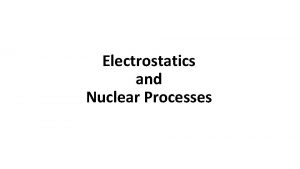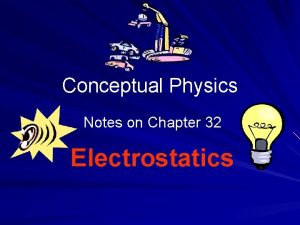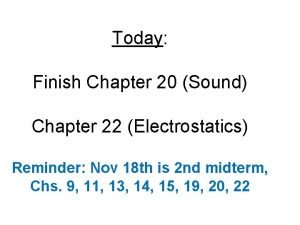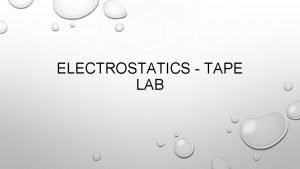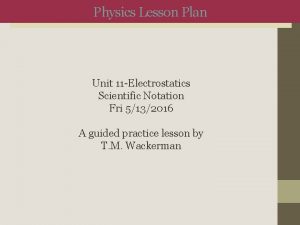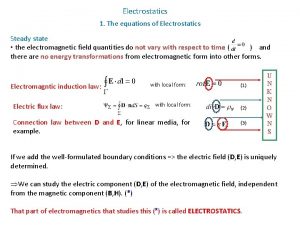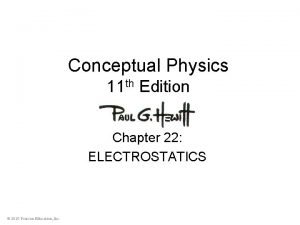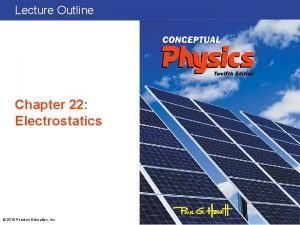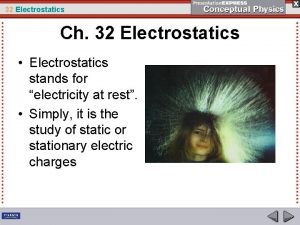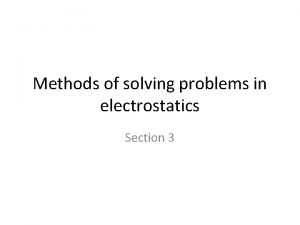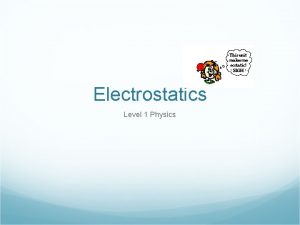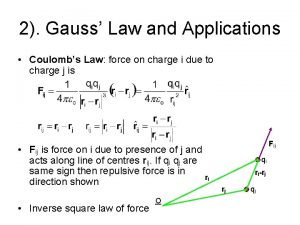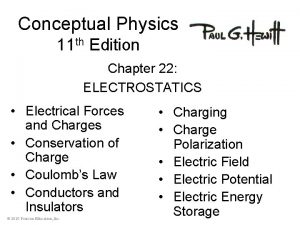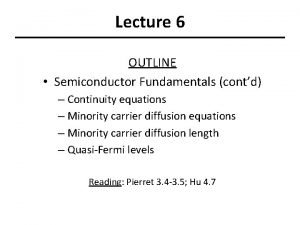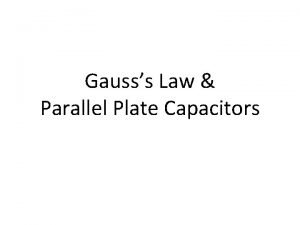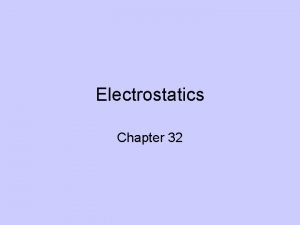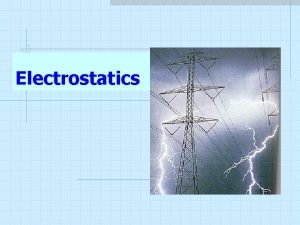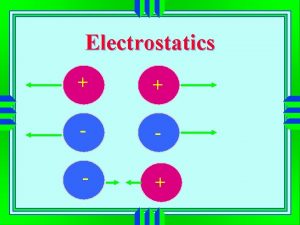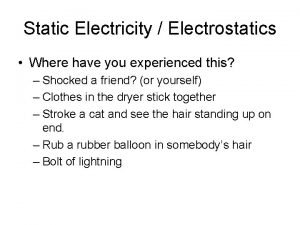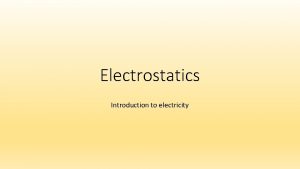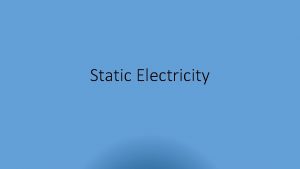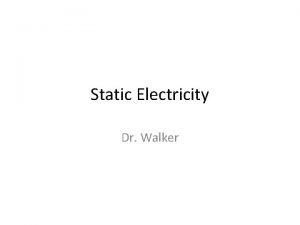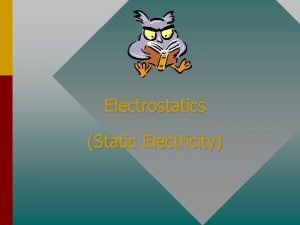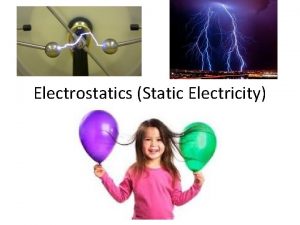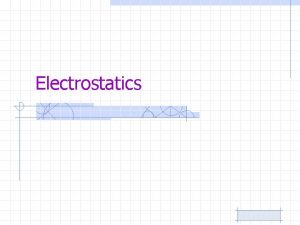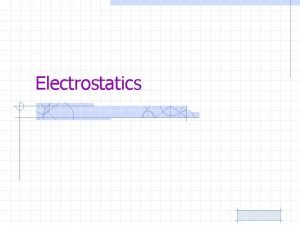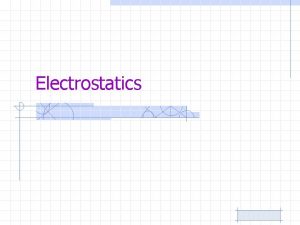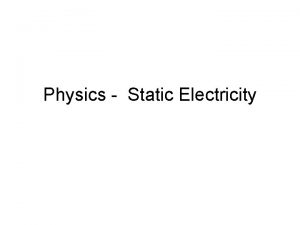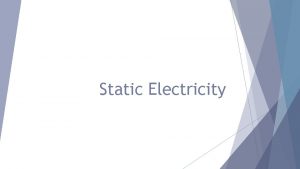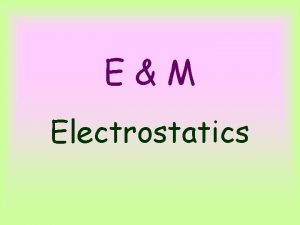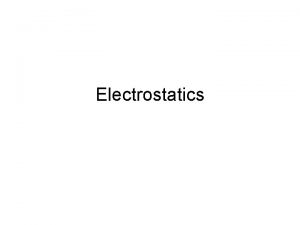ELECTROSTATICS Static Electricity Static electricity the accumulation of
























- Slides: 24

ELECTROSTATICS

Static Electricity Static electricity - the accumulation of excess electric charges on an object Only electrons move

Electrostatic Rules All charges are surrounded by electric fields • Any charge placed in an electric field will be pushed or pulled by the field (experience a force)

Opposite charges attract Similar charges repel Charges can act at great distances Electrostatic force is a very strong one

What is Going to Happen? +++ ---

What is Going to Happen? --- --

Field Lines • Field Lines cause force just like gravitational field lines -

Field Lines • Electric field lines always point towards a negative charge • Electric field lines always point away from a positive charge

Strength of a Field • Strength of an electric field can be determined by the force on a positive test charge placed in the field • The strength of a field increases as the test charge gets closer to the field • Calculated with E=F/q

Field Lines - +

Law of Conservation of Charges may be transferred from object to object but it cannot be created or destroyed

Conductors & Insulators • Conductors- Materials that easily transfer electrons – Metals (Copper) • Insulators- Materials that do not transfer electrons easily – plastic wood rubber and glass


Transferring a Charge • Three main methods –By Contact –By Induction –By Static Discharge

Charging by Contact • Done by touching or rubbing • Example: feet rubbing the carpet

Charging by Induction • Electrons move because of a nearby charged object • Example: negatively charged balloon near your sleeve causes your sleeve to be positively charged

Charging by Induction • How does a balloon stick to the wall or ceiling to “defy” gravity?

Static Discharge • A transfer of charge through the air between two objects because of the buildup of a static electricity – a spark! • Example: lightning

Coulomb’s Law q 1 q 2 FE=k d 2 FE is the electrostatic force (Newtons) q 1 and q 2 are charges (coulombs) d is the distance between the charges k = coulomb’s constant = 9 X 109 N m 2/c 2 1 Coulomb of charge = 6. 24 X 1018 e-

Relationship of Electrostatic Force and Distance • Recall the Inverse Square Law • Ex: If the distance between A & B is doubled, by what factor does the Force change?


Energy of Charged Particles • The energy of charged particles in an electric field can be calculated as • UE=q. V • Where q is the charge and V is the potential or voltage it experiences in the field

Questions: 1. Which particle is responsible for electrostatic forces? 2. Which method of transferring charge is by direct contact? 3. Field lines flow away from ___ charges and towards ___ charges 4. When placed between the positive and negative terminals of a discharge tube, which would move toward the positive terminal?

Questions: 5. What happens when a rubber rod is rubbed with a piece of fur, giving the rod a negative charge? (where do the e- move to? ) 6. If you ½ the distance of 2 charged particles, what happens to the strength of the force? 7. Give an example of an insulator. 8. Lightning is an example of ?
 Static electricity and current electricity
Static electricity and current electricity Electricity n
Electricity n Magnetism vocabulary
Magnetism vocabulary Electrostatics physics classroom
Electrostatics physics classroom Facts about electrostatics
Facts about electrostatics Conceptual physics electrostatics
Conceptual physics electrostatics Chapter 22 electrostatics
Chapter 22 electrostatics Electrostatics sticky tape lab answers
Electrostatics sticky tape lab answers Electrostatics lesson plan
Electrostatics lesson plan Coulomb to volt
Coulomb to volt Electrostatics
Electrostatics Conceptual physics chapter 22 electrostatics
Conceptual physics chapter 22 electrostatics Chapter 22 electrostatics
Chapter 22 electrostatics Electrostatics
Electrostatics Method of inversion electrostatics
Method of inversion electrostatics Conduction vs induction
Conduction vs induction Coulomb's law integral form
Coulomb's law integral form Conceptual physics chapter 22 electrostatics
Conceptual physics chapter 22 electrostatics The equation of continuity is
The equation of continuity is Electrostatics
Electrostatics Electricity at rest
Electricity at rest Type of charging processes
Type of charging processes Electrostatics
Electrostatics Electrostatics
Electrostatics Electric energy
Electric energy



